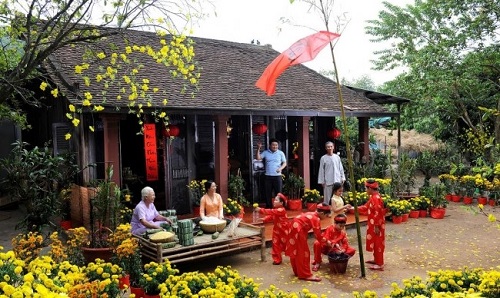The meaning of Vietnamese New Year
Popular festivals play a major role as a mirror and guardian of a nation’s cultural identity. The festival which best epitomises Viet Nam’s cultural identity is Vietnamese New Year or Tet.
Although endowed with honourable credentials, the new year by the solar calendar has never really been fully accepted in Viet Nam, at least not in the countryside. People pay polite homage to it but reserve their heart and soul for their own traditional lunar new year.
“Tet” is a word of Chinese Origin. It is the phonetic deformation of ‘tie’, a Sino-Vietnamese word which means ‘the joint of a bamboo stem and, in a wider sense, the ‘beginning of a period of the year’. The passage from one period to the next may cause a meteorological disturbance (heat, rain, mist) that must be exorcised by ritual sacrifices and festivities. Thus, there are many tets throughout the year (Mid-autumn Vietnamese New Year, Cold Food Vietnamese New Year, etc). The most significant of all is Tet Nguyen Dan (“Big Vietnamese New Year” or simply “Vietnamese New Year”), which marks the beginning of the new year according to the lunar calendar.
 |
| (Photo: Internet) |
Vietnamese New Year occurs somewhere during the last ten days of January or the first twenty days of February, nearly halfway between the winter solstice and the spring equinox. Although the lunar new year is observed throughout East Asia, each country celebrates it in its own way to conform with its own national psyche and cultural conditions.
For the Vietnamese people, Vietnamese New Year is like a combination of Thanksgiving, Christmas, New Year’s Day and Easter in the west. It is the festival of purity and renewal.
Nature always renews its youth, returning to its primary purity and freshness. People, who are part of nature, follow the same course.
Vietnamese New Year, the first day of spring, carries with it all the rebirth connotations that Easter has in the west. In the course of this period of universal renewal and rejuvenation, Vietnamese feel the spring sap welling up within them. This feeling has given rise to special customs: every deed during the first three days of the new year should be well intentioned and finely realised, for they symbolise and forecast actions over the coming twelve months. People abstain from getting cross and from using bad language.
The most shrewish mother-in-law will smoke the pipe of peace with her daughter-in-law, and quarrelling husbands and wives bury their hatchets. Children promise to be good and grown-ups hand the children gifts, usually a small denomination new note inside a red envelope, red being the colour representing good luck. The children are happy to be bought new clothes, and poor people receive charity. The ‘new’ world must be the best of all worlds. Once the festivities are over, normal activities resume with a new frame of mind after the inaugurating ceremonies: ‘Inauguration of the Seals’ for civil servants, ‘Inauguration of the Pen-brush’ for scholars and students, and ’'Inauguration of the Shop’ for traders.
For Vietnamese people, the Vietnamese New Year brings a message of confidence in humanity, redemption, hope and optimism.